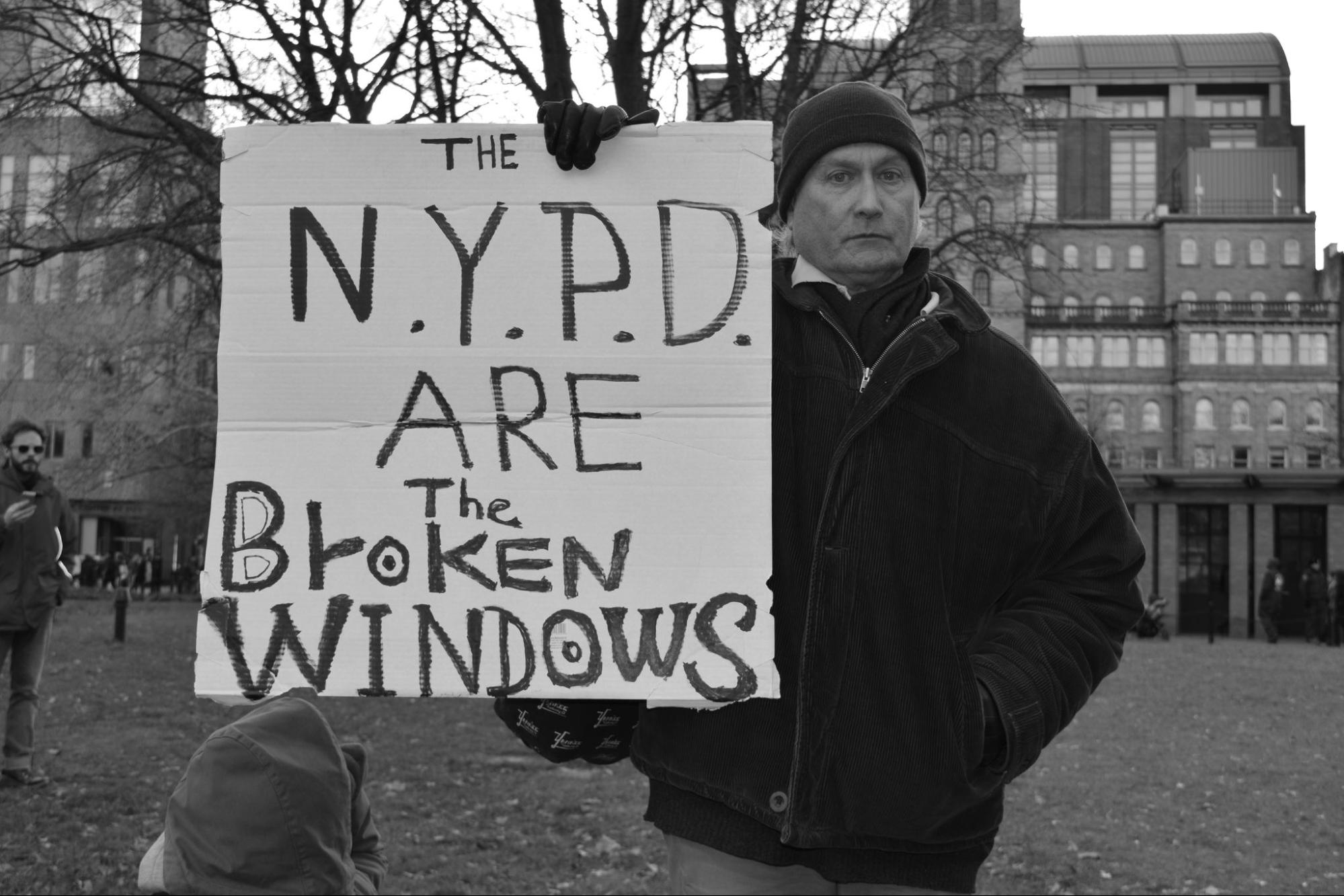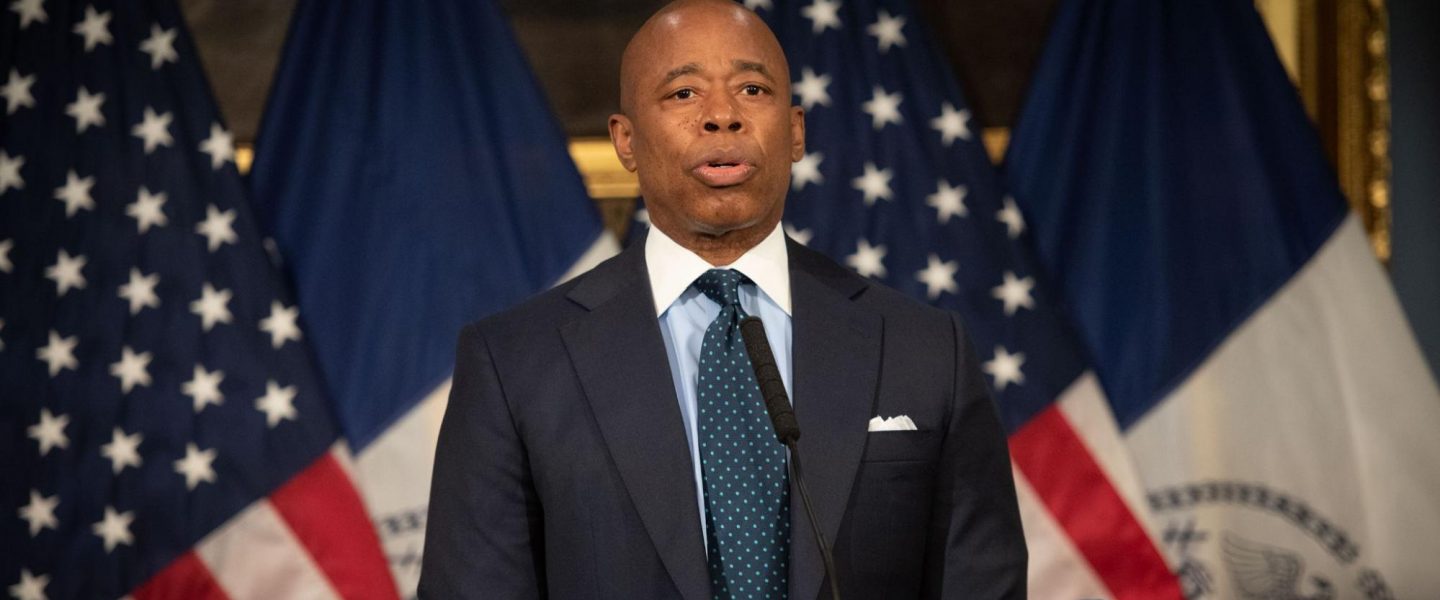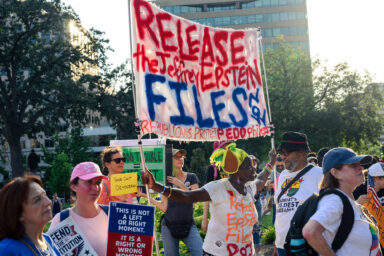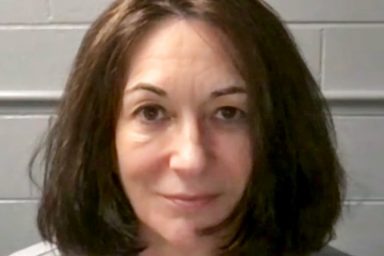New York City Mayor Eric Adams wants to use the police to stop gun violence. He can’t do it alone, but he’s trying anyway – and at a cost that advocates say isn’t worth it.
On February 2, President Joe Biden visited New York City, whose 8.8 million citizens are beset by what Mayor Eric Adams, a Democrat elected on a “tough on crime platform, calls “a crisis of gun violence.”
A few days prior, two NYPD officers were fatally shot while responding to a domestic violence call in Harlem. The first New York cops shot and killed by a suspect since 2017, they were only the highest profile of a number of prominent shootings in January, and a potent reminder of a nationwide trend.
Though crime in general remains at a historic low, gun-related crimes have been on the rise across the country since the beginning of the COVID-19 pandemic. In 27 American cities, homicides increased 44 percent between 2019 and 2021. In New York City, homicides increased 45 percent between 2019 and 2020.
And the public is worried. Fifty-two percent of Americans surveyed considered violent crime “a very big problem.”
Adams was elected last year largely due to his full-throated rejection of the “defund the police” movement and his understanding that New Yorkers feel unsafe. And Biden, facing tumbling poll numbers amid a pandemic-driven crime wave ahead of potentially crushing midterms, was in town to offer his full support for Adams’s ambitious and controversial “blueprint to end gun violence.”
Claiming “gun violence is a public health crisis that continues to threaten every corner of our city” and that demands both “intervention and prevention,” Adams wants to allocate $79 million to bolster a youth jobs program; he also plans to expand the city’s Crisis Management System, which uses civilian employees instead of police to mediate conflict.
But law enforcement is central to Adams’s plan.
Adams is reviving a controversial plainclothes officer unit — blamed in the past for racial profiling during the city’s “stop and frisk” era — to patrol certain low-income neighborhoods identified as high-violence areas. Adams is also deploying NYPD to tackle the “Iron Pipeline” — the flow of guns purchased in states with relaxed gun laws into strictly regulated New York — by conducting spot checks of luggage at city entry points, like bus and train stations, which could itself lead to racial profiling.
“When you are adopting a rhetoric of people who are male, pale, and stale in this state to say that racially insinuated criminal justice reform in our country is harming our city — I just think it’s wrong.” — Assemblywoman Latrice Walker
But much of the rest of Adams’s plan to solve New York’s violence problem relies on
lawmakers in Congress and in the state Legislature in Albany to make fixes that he can’t simply mandate — a de facto admission that the plan’s success or failure is outside the mayor’s control.
Without advances on federal gun control, the “Iron Pipeline” will continue to flow — a limitation Adams himself admits. Other critics say that the focus on law enforcement will send the city back into an era of over-policing, which will simply incarcerate people without making the city any safer.
“Any proposal or plan that will provide resources and funding to really underserved communities is a good thing, because then you get more stabilization of communities,” said Yung-Mi Lee, the legal director in the criminal defense practice at Brooklyn Defender Services, the public defender agency providing attorneys for low-income defendants in Kings County.
“But at the same time, there are parts [of the plan] that will amplify destabilization,” she added, referring to the cycle of arrest and incarceration that in part perpetuates crime.
“Some things make sense,” agreed Jeffrey Butts, the director of the Research and Evaluation Center at John Jay College of Criminal Justice. “Some elements are concerning.”
But Adams is forging ahead. So far, he’s failed to convince state lawmakers to roll back recent criminal justice reforms around cash bail and charging minors as adults. Instead, he prompted viral clapbacks.
“When you are adopting a rhetoric of people who are male, pale, and stale in this state to say that racially insinuated criminal justice reform in our country is harming our city — I just think it’s wrong,” said Assemblywoman Latrice Walker, a Brooklyn Democrat who helped write the recent bail reforms. Crime is rising all around the country, even in areas where “bail reform is not a thing,” Walker pointed out.
Adams’s office declined to comment for this story and instead directed WhoWhatWhy to the mayor’s public comments on the issue.
My full response to Mayor Adams's statement on public safety: pic.twitter.com/YCmbQF20kT
— Latrice Walker (@TheRealLatriceW) January 24, 2022
Crime Down, but Fears (and Guns) Up
Though both nonviolent and violent crime remain low compared to previous decades, a steady rise in murders and gun violence since the beginning of the COVID-19 pandemic has put many Americans on edge.
In 2020, the national murder rate increased 30 percent, the largest single-year change on record since the country has kept track, said Aaron Chalfin, an assistant professor of criminology at the University of Pennsylvania. In New York City, the jump in homicides was even higher — 45 percent.
But these numbers are fueling a misperception that crime is higher today than it was in the 1990s. That isn’t the case — in fact, nationally, violent crime today is roughly half what it was in 1991, according to FBI data, and the rates of offenses like larceny and robbery have dropped double digits between 2010 and 2020. The same holds true for New York City. According to data from the NYPD, the city recorded 2,262 homicides in 1990 and 488 in 2021. Between 1990 and 2021, larceny and robbery decreased more than 60 percent.
However, researchers are confident that one of the drivers of violent crime — and homicides in particular — is access to guns, and that’s absolutely on the rise.
“Gun carrying increased shortly after the pandemic,” Chalfin said. “Now, homicide [rates] didn’t increase until the summer of 2020. But around the time of the protests, the ingredients for violence were there.”

Gun sales far afield from New York affect the city’s crime rate. According to a report by New York’s attorney general’s office, between 2010 and 2015, 74 percent of the firearms used in a gun crime originated out of state.
Most came from states along the so-called “Iron Pipeline”: Pennsylvania, Virginia, North Carolina, South Carolina, and Georgia. All have more lenient gun laws than New York, which makes them the “source of choice” for gun traffickers bringing guns into New York, according to the attorney general’s report.
As Adams sends police to seek out firearms and conduct spot checks at Port Authority, his efforts will be undercut by the absence of federal legislation, critics say.
“You can have all the bills and policies you want [at the state and local levels], but as long as you have the flood in the market of guns, you have the police stuck in the middle and we’ll continue to have this conversation,” said Thaddeus Johnson, an assistant professor of criminology at Georgia State University.
During his New York visit, Biden unveiled his own proposal to curb gun violence. Proposals include beefing up the federal Department of Justice’s firearms trafficking task force. The DOJ will also train prosecutors on how to bring cases against users of “ghost guns,” weapons assembled from kits or parts obtained online that do not have a serial number.
But both Adams and Biden point to Congressional inaction on gun control as a hole in the response to violent crime. Adams’s plan urges Congress to pass legislation banning automatic weapons and implement universal background checks, though there’s little evidence that Congress will do so.
And that’s a major problem for Eric Adams. “If we don’t have a national approach to gun regulation, we will continue to see these shootings,” Butts said.
At the state level, Adams has asked state lawmakers to amend Raise the Age legislation passed in 2017 so that 16- and 17-year-olds charged with gun possession could once again be tried in criminal court rather than family court.
Experts say that this measure is overly punitive and will result in more arrests, more people in jail at Rikers Island — and more re-offenders.

It ignores research showing that a young person’s brain is still developing, and so they should not be tried as an adult, which was the original impetus behind the 2017 legislation, Lee argues.
”We also know that when young people get caught up in the system, when they receive periods of incarceration, even short periods, the likelihood of getting re-arrested increases five-fold,” she said.
And there isn’t any evidence to suggest that revising Raise the Age will reduce gun violence, Butts said.
“With [changing] Raise the Age, it’s presuming that a 16-year-old will stop before they walk into a store or a home with a gun in their pocket, and think, ‘Wait a minute, I think I heard that the mayor is changing the law, so maybe I shouldn’t go in there with this gun,’” he said. “Not only is that not how human beings think, it’s especially not how teenagers think.”
Rollbacks of bail reform have drawn similar criticism. State law passed in 2019 eliminated pretrial detention and cash bail for the vast majority of arrests. Adams wants state law altered yet again, this time to allow judges to weigh a suspect’s “dangerousness” when assessing their bail.
The conversation around bail reform and “dangerousness” is actually a distraction,
according to Carl Hamad-Lipscombe, director of Envision Freedom Fund, a community bail fund and advocacy organization.
Very few people who are released without bail are re-arrested for violent crimes or gun-related crimes, and so changes to bail laws will not decrease gun violence, he said.
Research shows the initial public safety benefits of imposing bail are outweighed by the long-term negative effect on communities. A study in the Journal of Law and Economics found pretrial detention lowers the overall arrest rate, but “this reduction in criminal activity is mostly offset by an increase in recidivism within two years after disposition.”
Adams met with Senate Majority Leader Andrea Stewart-Cousins (D) and Assembly Speaker Carl Heastie (D) in Albany to discuss adding a “dangerousness” component, but was rebuffed.
Speaking outside the capitol that day, Adams seemed to admit he doesn’t have Albany’s support.
“I can’t turn around and say, ‘Well, I didn’t get help from different places, so now my city is not safe.’ Nope, I’m not accepting that. My job is to make New Yorkers safe, that’s my job. If I get help from other places, that’s fine. Without that help, I still must make sure that New Yorkers are safe, and I’m not going to use any excuse for not doing that.”
Cops Back on the Beat
Unlike bail reform and gun control, Adams has near-total control over policing. The mayor, who served as a cop from 1984 to 2006 and was a first responder to the World Trade Center on 9/11, vows that the NYPD’s plainclothes anti-crime units won’t be responsible for a “stop and frisk” redux.
At the height of the stop-and-frisk era in 2011, police stopped over 685,000 suspects, 87 percent of whom were Black or Latinx, according to data from the ACLU of New York; nearly 90 percent of those stopped were innocent of any crime. In 2013, the New York Supreme Court declared that New York City’s stop-and-frisk policy constituted a civil rights violation.
In a clear nod to the stop-and-frisk era, the mayor vowed to avoid “the mistakes of the past.” Instead, “We’re going to be extremely precise on who we’re zeroing in on, because we know the shooters,” he said.
Rebranded “Neighborhood Safety Teams,” these plainclothes police will be deployed to the 30 precincts where 80 percent of violence occurs, according to Adams’s blueprint — which did not specify where. According to documents obtained by the New York Post, the plainclothes cops will focus on Harlem and Inwood in Manhattan, and in areas in Brooklyn including Brownsville, East New York, and Canarsie — all areas that are predominantly populated by people of color, according to the NYU Furman Center.
In Chalfin’s analysis, this is the focus required to make a dent in violence. Instead of flooding the streets with police and having them make a lot of arrests, Adams is “prioritizing gun investigations, gun arrests, [and] shooting investigations,” Chalfin said. “That feels like a more tailored thing to do.”
Butts says he trusts the mayor to reform the anti-crime units, but it won’t be easy.
“[Adams] knows how difficult it is to discipline the police,” he said. “When the police misbehave, they need to be held accountable. Hopefully, he takes that just as seriously as any other part of his job.”
For weeks, Adams has insisted that his plan intends to strike the right balance of justice and law enforcement to navigate the politics of the public safety debate, but his success as mayor largely hinges on whether New Yorkers see a real decrease in crime.
Though crime is at least partially caused by situations outside his control, Adams said he’s more than up to the task: “The totality of my life has prepared me for the moment that New Yorkers need right now.”



